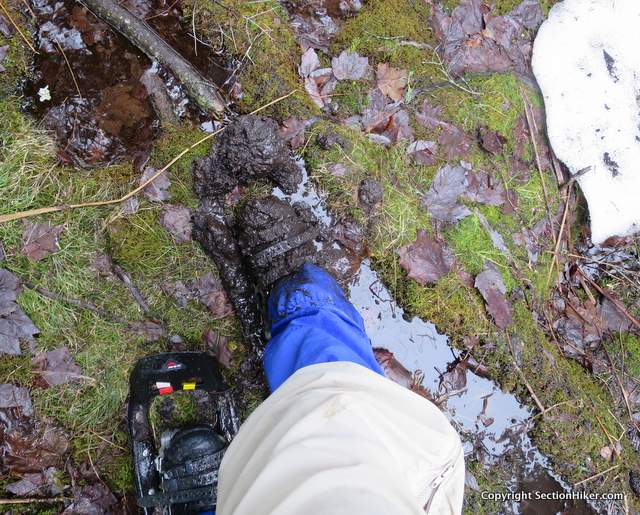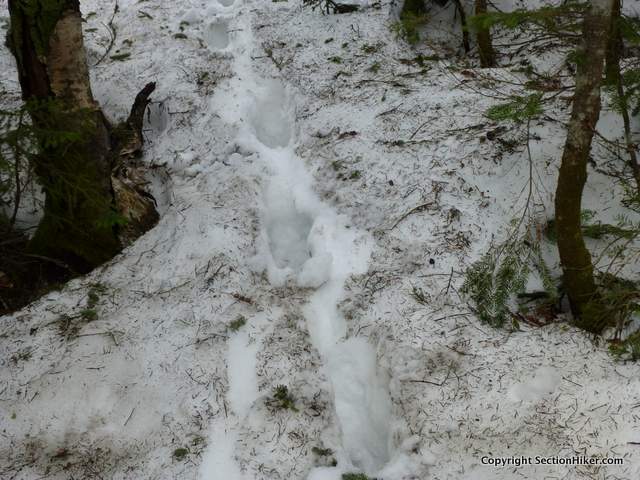
What is the right footwear for spring hiking: winter hiking boots or trail runners? When can you switch between the two? There is a point where avoiding frostbite trumps lightweight footwear and wearing insulated boots still makes sense.
Knowing when to choose between them requires understanding:
- where is the snow on your intended route?
- how deep it will be?
- what is the snow consistency like?
- how long you need to hike or snowshoe through it?
- what will the air temperature will be (at elevation)?
How do you decide?
Map the snowline: Start by mapping your route and looking at the elevation profile (tools like Caltopo.com are valuable for this). If you track weather forecasts, avalanche forecasts, and regional trip reports (including historical trip reports) over a 1-2 month window before your trip, you can develop a pretty good mental model of where the snowline is week-to-week and the elevation where you’re likely to hit snow. This can influence the route you choose and whether to defer your trip.

Solar Heating: How much sunlight does your route receive? How much forest cover does it has? What other microclimate variables that might limit the rate of snowmelt? For example: sun sheltered areas like ravines or cols are more likely to retain snow longer.
Surface Conditions: How much hiking traffic has your route received over the winter? Popular routes often develop a monorail layer of ice that persists longer than surrounding areas, while less popular routes melt off quickly. Microspikes can provide sufficient traction to hike monorail until it turns the consistency of mashed potatoes. After that, there’s almost no way to avoid postholing, even when wearing snow shoes.
Air Temperature: How warm or cold is the air temperature? Walking in ice water in warm sunny weather is a lot less taxing on your body than doing it in cold, wet weather. How serious is the hypothermia risk going to be?

Experience: Only one way to get this, I’m afraid. The good news is that you do compile considerable experience over time.
Spring Footwear Hedges
My spring hiking footwear can be grouped into three buckets: winter footwear, three-season footwear, and hedges between the two. The hedges are useful when you want to hike in three-season footwear through limited areas with winter conditions.
- Winter style boots, traction, and flotation
- Salomon Toundra Waterproof Insulated Boots (very lightweight) – 2 lbs 14 oz/pair
- Ragged Mountain Intervale High Gaiters (not waterproof, very lightweight) – 4.3 oz pair
- Hillsound Trail Crampons – 16.2 oz/pair,
- MSR Evo Ascent Snowshoes 22″ – 64 oz/pair, if dictated by snow depth
- Three-season footwear and traction
- La Sportiva Ultra Raptor Trail Runners – 1 lb 12 oz/pair
- Hillsound Trail Crampons – 16.2 oz/pair – if needed for monorail or rocky trails
- Insulation Hedges between the two extremes
- Oven roasting bags as a vapor barrier socks (1 oz per pair)
- Waterproof insulated socks (5.4 oz per pair)
The hedges between the two extremes are the most interesting, because they provide a lightweight way to extend the range of my trail runners so they can be worn when surface conditions are borderline winter.
- The oven roasting bags are worn over my wool socks inside my trail runners. They work a lot like waterproof, insulated boots but with less insulation. You sweat a little in them (see vapor barrier socks) but cold water doesn’t repeatedly soak your socks and flush away all the retained heat. The advantages of this method are its light weight and that it doesn’t require a larger sized shoe. But it only provides a moderate insulation benefit when wearing mesh trail runners.
- I’ve also had success this year using Hanz waterproof insulated socks, which also fit inside my trail shoes without requiring a larger sized shoe. They’re worn over my feet like regular socks, but they’re lined with fleece inside a waterproof membrane. You sweat a bit in them, they require gentle washing, and take a long time to dry. On the flip side, they’re an excellent hedge that makes it possible to hike in trail runners, even when extended post-holing is required. And they only weigh twice as much as an extra pair of socks.
 SectionHiker.com Backpacking Gear Reviews and FAQs
SectionHiker.com Backpacking Gear Reviews and FAQs
My hedge: neoprene socks worn inside of non-waterproof footwear. The socks I own are originally intended for wet-wading when fishing, and I do use them for that, but they do double duty as a vapor barrier and add some insulation as well. The downside is that they get pretty funky from sweat after each use and you have to size up your footwear to compensate for the additional thickness.
I was pleasantly surprised when those Hanz socks I’ve been using fit inside my regular trail runners. That was a win!
I have a pair of neoprene socks that are about as thick as my wool socks and they fit into my trail runners quite well. I originally bought them for a winter kayak expedition but they have become a valuable part of my hiking gear.
I cannot find a list for summer? all your articles are geared toward the other 3 seasons.
In light of some great prices at REI for some 200 g Salomon boots, decided to get those for spring when my Toundras get too hot and I’m not ready to switch to the summer footwear.
That’s exactly what I do (did). The lighter weight boot is good for “spring” conditions.
Haven’t used boots for ages. I guess my only ‘hedge’ is a pair of Sealskin socks which I wear if it is going to be very wet, and in particular in the early morning if my shoes are still wet and/or frozen from the night before. I generally just try to avoid hiking in snow if possible.